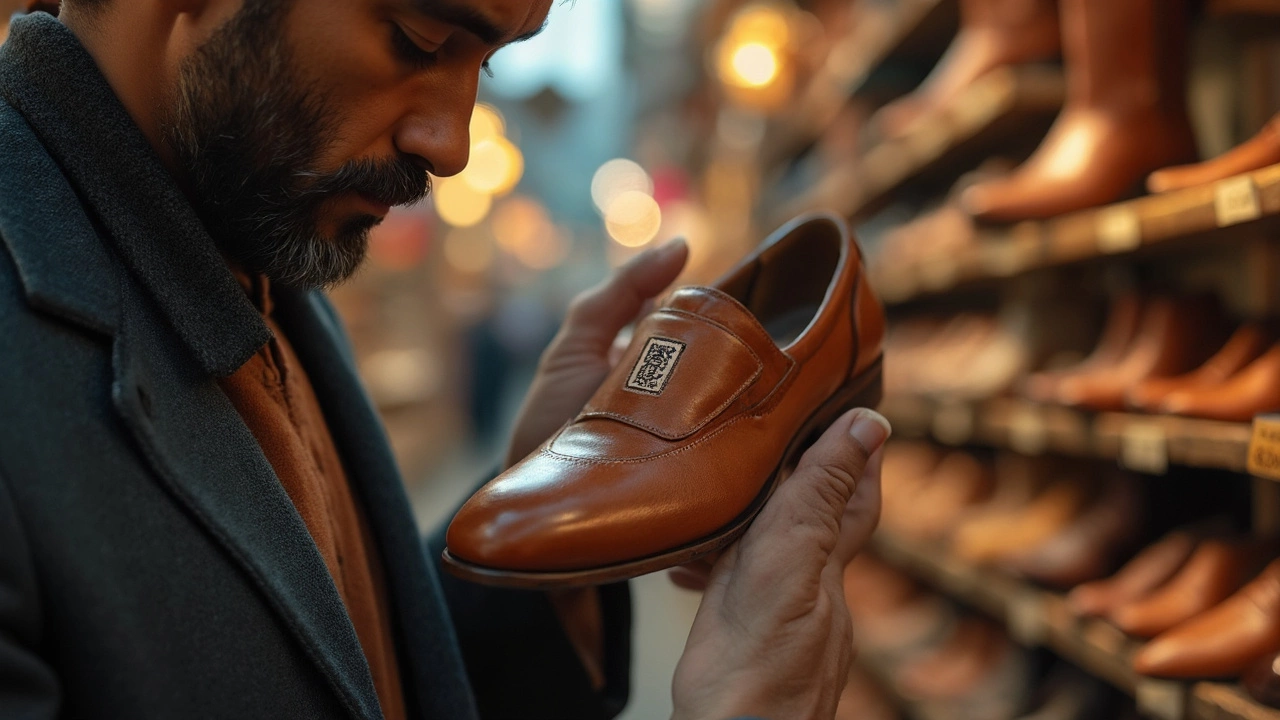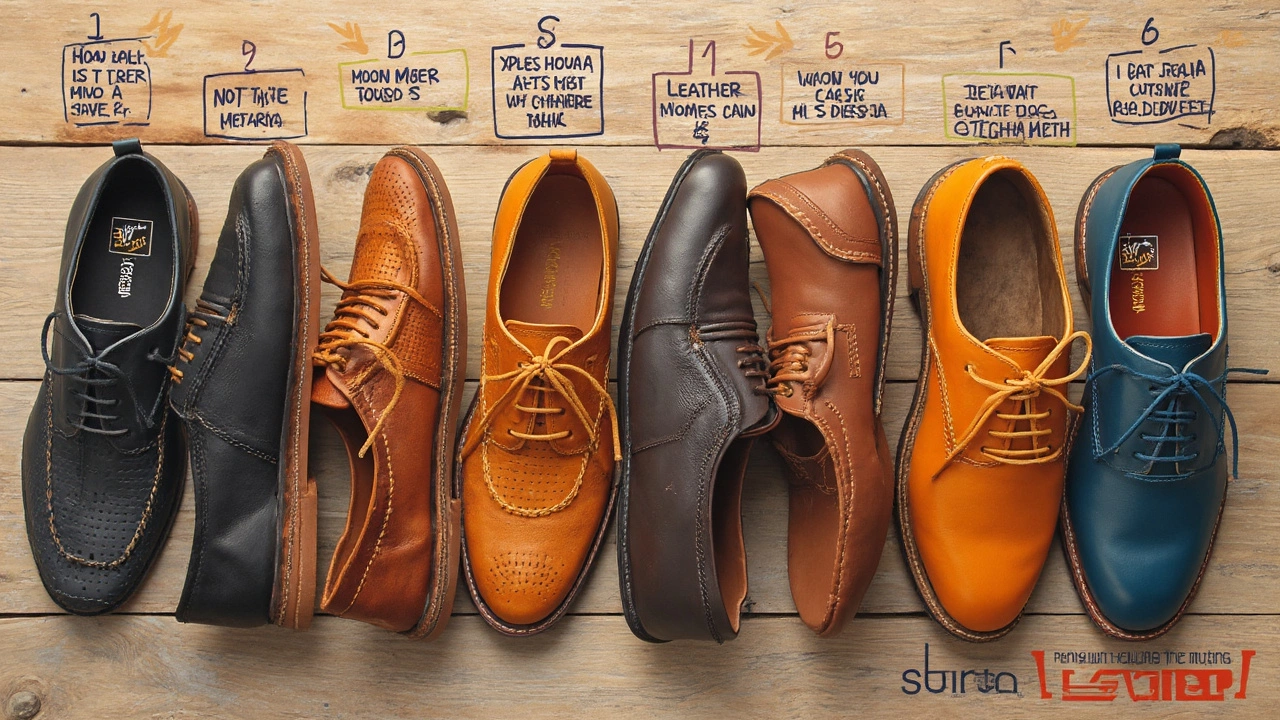Leather Shoes Symbol: How to Spot Genuine Leather Fast

Ever been shoe shopping and stared at the label, totally puzzled by weird shapes and symbols? The leather shoes symbol is one of those little details most people miss until they're back home and wondering if they just bought plastic shoes for leather prices. Knowing this symbol saves money, time, and annoyance—especially when kids like Clementine or Jasper don't have much patience in the shoe store.
The leather symbol looks a bit like a stretched-out hide—think of a fluffy cloud, but with squared-off corners. It’s usually stamped or printed on shoe labels, tags inside the shoe, or even right on the sole. If you spot this symbol, it means the part it’s next to is real leather, not fake stuff or synthetics. Before you add those shoes to your closet, it’s worth a quick check. Otherwise, you might end up disappointed when the material cracks or peels faster than you’d expect.
- What Does the Leather Shoes Symbol Look Like?
- Why the Symbol Matters When Buying Shoes
- How to Read Shoe Labels Like a Pro
- Quick Tips to Tell Real Leather from Fakes
- Common Mistakes with Leather Symbols
What Does the Leather Shoes Symbol Look Like?
The leather shoes symbol usually shows up as an outline that looks a lot like a stretched animal hide, with wavy or jagged edges—not a perfect rectangle or square. It's not random art; it's a worldwide sign for real leather. If you're scoping out shoe boxes or tags in stores like Target or Walmart, you'll see this symbol a lot, especially on higher-quality shoes. Watch out, though: just because a shoe has a leather symbol somewhere doesn't mean the whole shoe is real leather—look right where the symbol is, since it points to just that specific part (like the upper or lining).
Here's a clear table to help you know what you're looking at when you spot labels:
| Material | Symbol Shape | Meaning |
|---|---|---|
| Leather | Hide-shaped outline | Made from real animal hide |
| Coated Leather | Hide with grid or dots | Leather with coating for durability |
| Synthetic | Diamond or net shape | Man-made material like plastic |
| Textile | Fabric weave icon | Woven or knitted fabric |
If you check the inside of the shoe, the box, or sometimes even on the sole, you'll usually spot these symbols. Shoes for kids almost always include them—so if you've got picky kiddos like Clementine and Jasper, knowing this saves time and arguments in the store. If you're after genuine leather shoes, always chase that hide-shaped icon and double-check it sits next to 'Upper' or 'Lining' on the tag, not just 'Outer Sole.' That tells you which part of the shoe is actually the real deal.
- The hide-shaped outline is the official leather symbol used across Europe, the US, and Asia.
- If a shoe is called “leather” but doesn't show this symbol anywhere, that's a red flag.
- Shoes often have more than one material. Always match the symbol to the right part (look for arrows or labels on the chart).
So next time you're in the shoe aisle, just hunt for that classic hide-shaped logo. That's your shortcut to finding leather shoes symbol and not getting tricked by just any shiny new pair.
Why the Symbol Matters When Buying Shoes
That tiny leather symbol isn't just for show. It actually helps you figure out what you're paying for before you leave the store. With so many brands blending different materials, spotting that leather symbol is your shortcut to avoiding letdowns—like shoes peeling after two months, or smelling like plastic instead of breaking in like good old leather.
Here's a big reason to look for it: real leather breathes much better than fake stuff. Your feet sweat less, stink less, and the shoes mold to your foot over time. Plus, real leather usually lasts 2 to 4 times longer than synthetic shoes. Not knowing the difference can be one expensive mistake, especially if you walk a lot or need shoes for work.
- Real leather shoes can last 5–10 years (or longer) with basic care. Synthetics often fall apart within one or two years of regular wear.
- That leather shoes symbol guarantees the labeled part of the shoe is really leather—often just the upper, so always double-check.
- Some companies try to trick buyers with words like "genuine leather," "PU leather," or fake leather grain—without the symbol, you can't be sure.
Check out these simple facts that might surprise you:
| Material Type | Typical Lifespan | Breathability |
|---|---|---|
| Real Leather | 5-10 years | High |
| Synthetic | 1-2 years | Low |
So if you want shoes that won't let you down, save yourself the hassle and spot that symbol before reaching the checkout. Your feet (and your wallet) will thank you.

How to Read Shoe Labels Like a Pro
If you grab a pair of shoes off the shelf and flip them over, you’ll usually spot a tag or sticker with tiny icons and material lists. Decoding these isn’t as tricky as it looks, but a little know-how goes a long way.
Here’s a crash course on what those shoe symbols mean:
- The leather shoes symbol looks like an animal hide—kind of a wonky rectangle with wavy sides. If you see this near the upper, lining, or sole, it’s leather.
- A checkerboard or grid means coated leather. This is leather with a coating, usually plastic, less breathable and not as lasting.
- A diamond or rhombus = manmade (synthetic) material. These don’t breathe like leather and often wear out faster.
- A mesh or crisscross symbol points to textile, meaning fabric-style shoes—think trainers and some flats.
Shoe labels break down what material is used for three parts:
- Upper – the visible top part.
- Lining & sock – the inside you touch with your foot.
- Outer sole – the part that hits the ground.
Here's a quick look at what you might see on shoe labels and what they mean:
| Part of Shoe | Common Symbol | Meaning |
|---|---|---|
| Upper | Hide shape | Genuine leather |
| Lining & Sock | Diamond | Manmade/ Synthetic |
| Outer Sole | Grid or Mesh | Coated leather or textile |
If the label is missing, check the brand’s website—some break down every detail in the product description. And if the tag is in another language, symbols are usually the same across Europe and the US, thanks to international labeling standards.
One more tip: if you’re shopping for kids, a lot of parents don’t notice that some "fancy" shoes are just plastic with a leather look. That’s why a quick look at the symbols can mean better quality (and fewer melted shoes on hot playgrounds).
Quick Tips to Tell Real Leather from Fakes
Trying to figure out if your shoes are real leather or a high-quality fake? You don’t need to be Sherlock Holmes—just follow these quick checks and you’ll avoid getting duped.
- Sight test: Check for the leather shoes symbol on the tag, box, or even the inner lining. No symbol? Be wary.
- Touch test: Real leather feels grainy, a bit uneven, never totally smooth. Fakes feel plastic-y or rubbery. Rub your thumb over it—leather has give, while plastic resists.
- Smell test: Leather smells earthy and natural, kind of like your grandpa’s old jacket or a new handbag. Synthetic shoes usually just smell like glue or chemicals.
- Bend test: Flex the shoe. Real leather creases in tiny lines. Fakes mostly stay the same or crack oddly.
- Edge test: Flip the shoe and check the edges. Leather looks fibrous and rough-cut. Fakes have super clean, plastic-like edges.
If you want some quick hard facts, here’s a handy table comparing the real deal with wannabes:
| Test | Real Leather | Fake Leather |
|---|---|---|
| Symbol Present | Usually | Rarely |
| Feel | Soft, grained, flexible | Slick, uniform, stiff |
| Smell | Earthy, pleasant | Chemical, plasticky |
| Bend | Forms wrinkles/creases | Stays flat or cracks |
| Edge | Rough, uneven | Clean, shiny, plastic |
Don’t just take the sales pitch at face value. Use your senses and these tricks to make sure you’re getting what you pay for—especially if you’re buying for kids and don’t want those new school shoes falling apart in a couple months.

Common Mistakes with Leather Symbols
A lot of people mess up when it comes to reading the leather symbol, especially since shoe brands don’t always make things super clear. You might see the symbol and think it means the whole shoe is leather, but that’s not always the case. The symbol is usually next to a specific part—like just the upper, lining, or sole. That means you could buy a pair of shoes thinking they’re all genuine leather, when only the toe or heel is the real deal. Always check what part of the shoe the symbol is pointing to!
There are also different symbols for materials. The leather shoes symbol looks like an animal hide, while other shapes (like a diamond) stand for man-made stuff. If you’re in a hurry, it’s easy to grab the wrong pair just because you saw a symbol without looking close enough. And watch out: some products try to trick you with words like “leather upper” but slap a fake symbol on the box. That’s usually a sign something fishy’s going on.
Another mistake? Trusting country-of-origin alone. Just because shoes are made in Italy or Spain doesn’t guarantee they’re full leather. Always double-check the symbols, even if the brand has a good reputation. Some shops even have sample cards with symbols and explanations—grab one if you see it, or pull up a picture on your phone for reference.
- Always match the symbol to the shoe part it’s next to.
- Don’t mistake the diamond symbol for leather—it means synthetic.
- If the label’s missing or looks tampered with, ask a clerk before you buy.
- Be extra careful at outlet stores or markets where labeling can be sketchy.
The more you check for that squarish hide symbol and pay attention to placement, the less likely you are to end up with regret buys that don’t last.